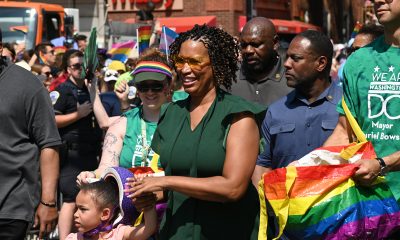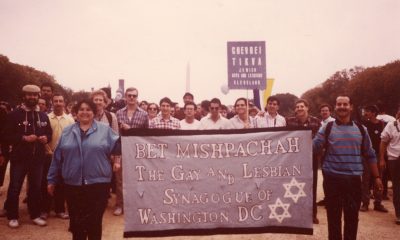a&e features
Pride, activist groups, the gay press and more take form in wake of Stonewall riots
Bumps and hurdles loomed in most areas as movement came of age in ‘70s and beyond
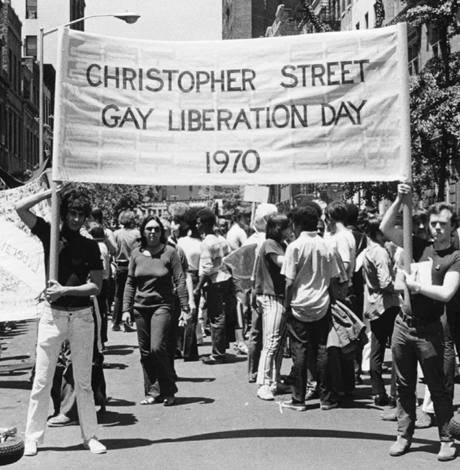

The most impactful legacy of Stonewall isn’t what happened those few nights, but what grew out of it — annual Pride celebrations, of course, but also the gay press, a proliferation of rights groups, de-classification of homosexuality as mental illness, disco, sexual lib, AIDS and more. Whole books have been written on each of these topics, for anyone interested in further study.
THE BIRTH OF PRIDE
Some of the people who rioted starting on June 28, 1969, once things settled, started to organize and a group called the Stonewall Veterans Association, which is still in existence, formed.
In November 1969, Craig Rodwell (1940-1993), owner of the Oscar Wilde Memorial Bookshop (the country’s first gay bookstore), along with his partner Fred Sargeant, Ellen Broidy and Linda Rhodes, proposed a New York City march to commemorate the riots. He introduced a resolution at the Eastern Regional Conference of Homophile Organization (ERCHO) in Philadelphia.
“We propose that a demonstration be held annually on the last Saturday in June in New York City to commemorate the 1969 spontaneous demonstrations on Christopher Street and this demonstration be called Christopher Street Liberation Day,” the resolution said. “No dress or age regulations shall be made for this demonstration.”
The concept of Pride being held in other cities simultaneously was ingrained in the concept from the outset.
“We also propose that we contact homophile organizations throughout the country and suggest that they hold parallel demonstrations on that day. We propose a nationwide show of support,” the resolution stated.
Christopher Street Liberation Day was held June 28, 1970, the first gay Pride march in the U.S. It covered 51 blocks to Central Park with a parade permit reluctantly delivered just two hours before the scheduled start time. Marches were simultaneously held in Los Angeles and Chicago. In 1971, it had spread to Boston, Dallas, Milwaukee and three European cities as well. Pride in Washington started in 1975.
Since 1984, the parade and related events in New York have been produced and organized by Heritage of Pride, a volunteer, non-partisan LGBT group.
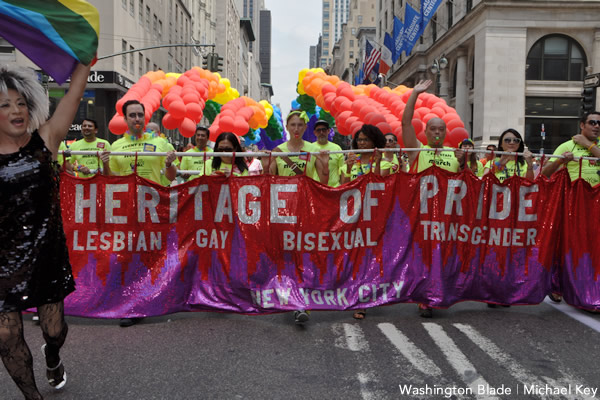
THE GAY PRESS
The gay press didn’t begin with Stonewall. The earliest known publication had an inauspicious start. In 1947, an underworked secretary trying to look busy, typed, stapled and distributed 12 copies of Vice Versa, which she dubbed “America’s gayest magazine.” Since then, thousands have followed in her steps producing about 2,600 — at their height — publications ranging from weekly newspapers to more radical tabloids to glossy monthly magazines.
Seminal pre-Stonewall publications included Ladder, Vector and the Los Angeles Advocate.
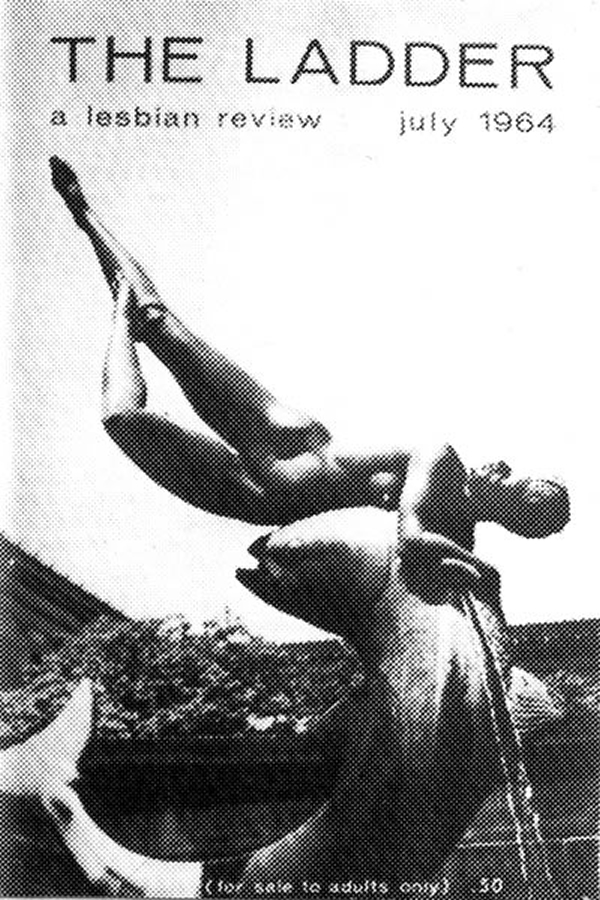
The number of these publications exploded after Stonewall. It was seen as necessary as even the most liberal alternative press of the day — in New York, The Village Voice, refused to print the word gay. “Throughout the ‘70s, people who depended solely on mainstream media for news would hardly have been aware of the gay rights movement,” writes author/historian Eric Marcus in his 2002 book “Making Gay History.” “With a few notable exceptions, the television networks, daily newspapers and newsmagazines gave little coverage to gay issues.”
“After the apocalyptic Stonewall impulse, the press erupted in so many directions that it is impossible to document when each publication was founded, how long it existed or who edited it,” writes Rodger Streitmatter, author of “Unspeakable: the Rise of the Gay and Lesbian Press in America.”
“Our Own Voices: A Directory of Lesbian and Gay Periodicals” listed 150 publications by 1972, Streitmatter writes.
One of the most influential was called simply GAY, started in December 1969 by gay press veterans (and partners) Jack Nichols and Lige Clarke, who’d covered Stonewall. It soon became, according to Streitmatter, the “newspaper of record for gay America.”
Veteran activist Lilli Vincenz, who wrote a lesbian column for GAY, is quoted in “Unspeakable” as having said, “It was the newspaper of the day. If you were gay and you wanted to find out what was going on in the world, you turned to GAY.”
It sold 20,000 copies of its first issue (at 40 cents per copy) and reached a monthly circulation of 25,000 by its second issue, figures that took the Advocate two years to build. Within six weeks, two other New York-based newspapers were launched — Come Out! and Gay Power. GAY continued until Clarke was murdered in 1975.
Streitmatter writes later in the book that the publications “that survived the aftershocks of Stonewall were those with a combination of calm voices and stable finances,” citing GAY in New York and The Advocate in Los Angeles as leaders.
But two months before GAY was launched, in October 1969, Vincenz and a small group of men and women met in the basement of a Connecticut Avenue building to work on the first issue of the Gay Blade. The monthly, mimeographed one-sheet issued by a volunteer staff contained three columns of news, community notices and a small advertisement for someone who wanted to sell a car, writes author Edward Alwood in his 1996 book “Straight News: Gays, Lesbians and the News Media.”
“By distributing copies at the city’s gay and lesbian bars, they quickly established the Blade as a source of valuable information that was not available from any other source,” Alwood writes.
Editor Nancy Tucker told Alwood they printed “things that we thought were important to the mental health and social welfare of other people like us,” Alwood quotes her as having said. “Periodically we ran warnings of blackmailers who hung around Dupont Circle or the gay bars. We wrote about rough cops. There were plenty of military and government workers who were undergoing some type of security investigation and all of those people needed to know about their rights. These were a heavy orientation for us.”
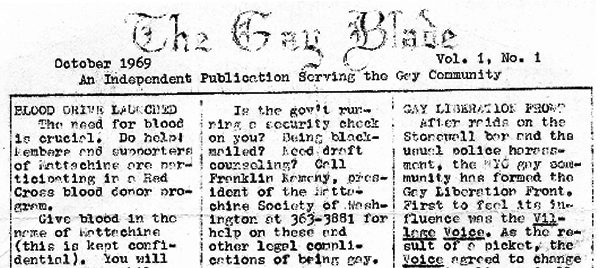
It was the first of a new generation of gay papers that included Gay Community News in Boston, NewsWest in Los Angeles, Gay News in Pittsburgh and GayLife in Chicago, Alwood writes.
“Unlike the early homophile press, which stressed identity and cooperation, this second generation concentrated almost solely on political change and resistance,” Alwood writes.
The Gay Blade was rechristened the Washington Blade in 1980 and went to weekly publication in 1983. It’s the oldest continually operating LGBT newspaper in the country. It celebrates its 50th anniversary in October.
REGIONAL GAY RIGHTS GROUPS
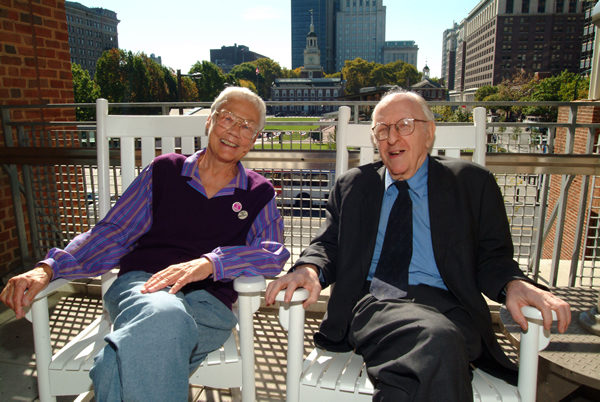
Although groups like the Mattachine Society and Daughters of Bilitis had been around since the ‘50s, things became more emboldened after Stonewall. The Gay Liberation Front was the first organization to use gay in its name. Previously, all “homophile” (as they were known) groups purposefully did not.
Legendary early activists Barbara Gittings and Kay Lahusen were vacationing on Fire Island when they heard about Stonewall. Upon returning to the city in September, they began attending meetings of the Gay Liberation Front and encountered a much different group of people and ethos.
“They were huge meetings, it was the best theater in town,” Lahusen is quoted as having said in “Making Gay History.” “This was the heyday of radical chic … and here I was this plain Jane dinosaur from the old gay movement.”
Gittings said there was zero acknowledgement of the pre-Stonewall efforts.
“Suddenly here were all these people with absolutely no track record in the movement who were telling us, in effect, not only what we should do but what we should think,” she’s quoted as having said in “Making Gay History.” “The arrogance of it was really what upset me.”
Gittings said she and Frank Kameny were even asked at one Philadelphia meeting who they were and what they were doing there.
“For once, I think even Frank was dumbfounded,” Gittings is quoted as having said. “As if we owed them an explanation.”
Gittings said right after Stonewall, the Gay Liberation Front and the Mattachine Society, which some perceived as having been slow to respond to the riots, were the only two active groups.
“Mattacine was so stuffy and its day was over,” Lahusen said in “Making Gay History.” “These organizations seem to have a built-in life expectancy.”
“Mattachine wasn’t up to managing the lively response to the Stonewall riots and GLF came in to fill the void,” Gittings told author Marcus.
The Gay Liberation Front (a name used by multiple groups over the years), however, disbanded after just four months when members were unable to agree on operating procedure. In December 1969, some people who had attended Front meetings but left frustrated formed Gay Activists Alliance (GAA), an “orderly” group to be focused entirely on gay issues. A D.C. chapter had formed by 1971. It became the Gay & Lesbian Activist Alliance in the ‘80s, and continues to this day.
Many of the main groups with major name recognition today started later. The National Gay Task Force (now the National LGBTQ Task Force) started in 1973. Two groups merged to form the largest, Human Rights Campaign, in the early ‘80s.
Many of the state groups came much later, uniting around the marriage issue. The California Alliance for Pride and Equality was founded in 1999 and only became Equality California in 2003. The now-dissolved Empire State Pride Agenda was founded in 1990 through a merger of two earlier groups. By 2005, it was the largest state lobbying group.
AIDS
In a roundabout way, Stonewall, in time, also brought attention to the disparate health care needs of LGBT people. That’s the contention of Perry N. Halkitis, dean of Rutgers School of Public Health and author of the new book “Out in Time: From Stonewall to Queer; How Gay Men Came of Age Across the Generations.”
“The riots allowed gay people to say ‘we exist’ and create a demand for health equity,” Halkitis said in a recent interview with tapinto.net. “The civil disobedience of Stonewall served as a catalyst to the activism of the AIDS era, which in turn has contributed to the foundations of how public health today emphasizes social justice and health equity.”
Although initially about wholly separate issues, Stonewall started a movement that was eventually “catapulted” 13 years later when HIV hit, he says.
“As the riots framed the basis for the recognition of gay people as viable members of the population, the AIDS crisis of the 1980s and ’90s created the circumstances by which they would come to demand that the government and society attend to their well-being,” Halkitis said in the tapinto.net interview. “Before then, gay people kept silent and were invisible to their doctors, who were unaware they were gay or did not understand the mental health and drug issues they were facing. The AIDS crisis shined a light on the fact that there was this population that needed specific health services beyond what was given to the general population.”
Dr. Demetre Daskalakis, deputy commissioner for the Division of Disease Control of the New York City Department of Health and Mental Hygiene, said in a New York Times interview last week that the histories of Stonewall and AIDS are inextricably linked and have affected what’s still happening today.
“It’s so critical that you had an uprising, and it became not just folks being downtrodden by their system but actually then fighting back,” Daskalakis told the Times. “I feel that the fighting spirit now is like the ACT UP experience in New York. There was a feeling that it was part of LGBTQ rights to ask for faster, better support and funding to fight HIV. … I think the legacy of activism remains powerful decades later.”
As the number of deaths soared, gay and lesbian people and gay rights organizations redirected their energies, Marcus writes in “Making Gay History.”
“Many thousands of gay people who had never participated in gay rights efforts were motivated to join the fight against AIDS,” he writes. “New organizations joined existing ones to provide care for the sick and dying, conduct AIDS education programs, lobby local and federal governments for increased funding for AIDS research, pressure medical researchers and drug companies to become more aggressive in their search for treatments and a cure and fight discrimination against people with AIDS and those infected with HIV.”
AMERICAN PSYCHIATRIC ASSOCIATION
In 1973, the American Psychiatric Association removed the diagnosis of “homosexuality” from the second edition of its Diagnostic and Statistical Manual.
In the mid-20th century, some homophile activist groups accepted psychiatry’s illness model as an alternative to societal condemnation of homosexuality’s supposed “immorality” and were willing to work with professionals who sought to “treat” or “cure” them, Jack Drescher writes in his 2015 study “Out of DSM: Depathologizing Homosexuality.” Other activists, however, forcefully rejected the pathological model as a major contributor to the stigma and in the wake of the Stonewall riots, brought modern sex research theories to the attention of the APA.
Believing psychiatric theories to be a major contributor to anti-gay social stigma, activists disrupted the 1970 and 1971 annual APA meetings.
Although, Drescher writes, there were rumblings happening within the world of psychiatry that helped the gay cause, “the most significant catalyst for diagnostic change was gay activism.”
Kameny and Gittings spoke on a 1971 APA panel entitled “Gay is Good.” They returned in ’72, joined by Dr. John Fryer, who appeared anonymously as a “homosexual psychiatrist.”

APA’s Nomenclature Committee eventually recommended removing homosexuality when it determined it unique among the supposed mental disorders in that in and of itself, it did not cause distress nor was it associated with generalized impairment in social effectiveness of functioning.
It wasn’t a completely cut-and-dried affair; the psychiatric world continued grappling with the controversial decision for years, Drescher writes in his scholarly article, but it was “the beginning of the end of organized medicine’s official participation in the social stigmatization of homosexuality.”
Many people, both inside and outside the psychology profession, claimed the APA had succumbed to pressure from gay activists and while it was true that many gay men and lesbians had exerted pressure, there were also respected psychiatrists within the organization who worked to affect the change, Marcus writes in “Making Gay History.” One was Dr. Judd Marmor, a Los Angeles psychiatrist.
“We didn’t merely remove homosexuals from the category of illness. We stated that there was no reason why a priori a gay man or woman could not be just as healthy, just as effective, just as law abiding and just as capable of functioning as any heterosexual,” Marmor is quoted as having said in Marcus’s book. “Furthermore, we asserted that laws that discriminated against them in housing or in employment were unjustified. So it was a total statement.”
Shortly thereafter, the American Psychological Association and the American Bar Association came out in support of gays.
“It was an important step that we took,” Marmor said in “Making Gay History.”
DISCO
Disco music, a type of dance music and the subculture around it that emerged in the ‘70s from the U.S. urban nightlife scene, is inextricably linked to post-Stonewall gay life.
Its “four-on-the-floor” beats, syncopated basslines and shimmery instrumentation flourished in venues popular with black, Latinx and gay nightlife lovers mostly in major cities on the East Coast at the dawn of the ‘70s. The most popular disco artists were Donna Summer, Gloria Gaynor, the Bee Gees, Chic, KC and the Sunshine Band, the Village People, Thelma Houston and others. Pop acts like Diana Ross and Michael Jackson, who’d had hits in other genres, jumped on the disco bandwagon with success.
In his essay “In Defense of Disco,” gay writer Richard Dyer writes that disco gave gay men a mainstream musical genre they could embrace.
“All my life, I’ve liked the wrong music,” he writes. “I never liked Elvis and rock ’n roll; I always preferred Rosemary Clooney. And since I became a socialist, I’ve often felt virtually terrorized by the prestige of rock and folk on the left. … Disco is more than just a form of music, although certainly music is at the heart of it. Disco is also kinds of dancing, club, fashion, film — in a word, a certain sensibility.”
Thematically, Dyer (whose essay is included in the 1995 anthology “Out in Culture: Gay, Lesbian and Queer Essays on Popular Culture”), writes that disco has both rhythmic and lyrical appeal to gay men.
“No wonder (Diana) Ross is (was?) so important in gay male scene culture for she both reflects what that culture takes to be an inevitable reality — that relationships don’t last — and at the same time celebrates it, validates it.”
“Our music owes so much to the gay clubs that first nurtured it, which in turn helped to create safe spaces that allowed a marginalized population the freedom to be themselves,” writes Ned Shepard in a 2016 Cuepoint essay.
He cites a comment from Barry Walters from Billboard.
“The history of dance music in America and the history of LGBT folks — particularly those of color — coming together to create a cultural utopia was and still is inseparable. Neither would have happened without the other,” Walters is quoted as having said.
SEXUAL LIBERATION
Sexual liberation in the pre-AIDS era for lesbian and gay activists was a heated topic. Gay men especially enjoyed dabbling liberally without any of the baggage sexually adventurous women — despite this being the era of Helen Gurley Brown and her landmark 1962 book “Sex and the Single Girl” — faced, but the concern that gay rights would be overly associated with a free sex narrative was contentious and variations of that argument continue to this day.
The 1980 William Friedkin (“The Exorcist”)-directed movie “Cruising” was a nadir of the conundrum.
“There was … a political and ideological split in the gay community about whether or not it was valuable or necessary to show the leather and sadomasochism aspect of the community on screen,” recalls “The Celluloid Closet” author Vito Russo in “Making Gay History.” “There were middle-of-the-road gays who found this kind of thing horrifying. Just because you’re gay doesn’t mean you were necessarily acquainted with the more far-out aspects of gay sexuality, especially in the 1970s. There were a lot of gay men, and certainly lesbians, in this country who would have been deeply shocked by the sex bars in New York. … Suddenly the issue became, ‘Do we want to present this to the world as the way gay people are?’ The public was not going to distinguish between one group of gay people and another.”
Nancy Walker (not the “Rhoda” actress) writes of her volunteer work in the early ‘70s at the Boston-based weekly Gay Community News in “Making Gay History.”
“We wanted gay liberation but what did that mean,” she writes. “Did it mean equal rights? To me, that’s all I ever wanted. On the other hand, some of them wanted to be able to fuck in the parks. Well, that’s wonderful, but if they did, I wouldn’t take my children there either. How far is sexual freedom supposed to go? Are you allowed to have intercourse on the street corner because you feel like doing it? How does that make you different from a dog? What happens to civilization when people lose all their socialization and have sex, where and with whom they please? We have to have a little bit of self control, a little discipline. I’m sorry, but I’m not interested in sexual freedom. I’m interested in being able to live.”
Ultimately things somewhat self calibrated — AIDS brought a day of reckoning writ large, it didn’t manage to kill off gay bathhouse culture and, of course, antiretroviral meds and PrEP were game changers in the AIDS war. But it’s not all gay “Pollyanna.” Entrapment of cruising gay men remains a problem. As recently as 2015 in Rehoboth Beach, Del., of all places, 12 men were arrested for public lewdness by undercover police officers.
a&e features
Tristan Schukraft on keeping queer spaces thriving
New owner of LA’s Abbey expands holdings to Fire Island, Mexico
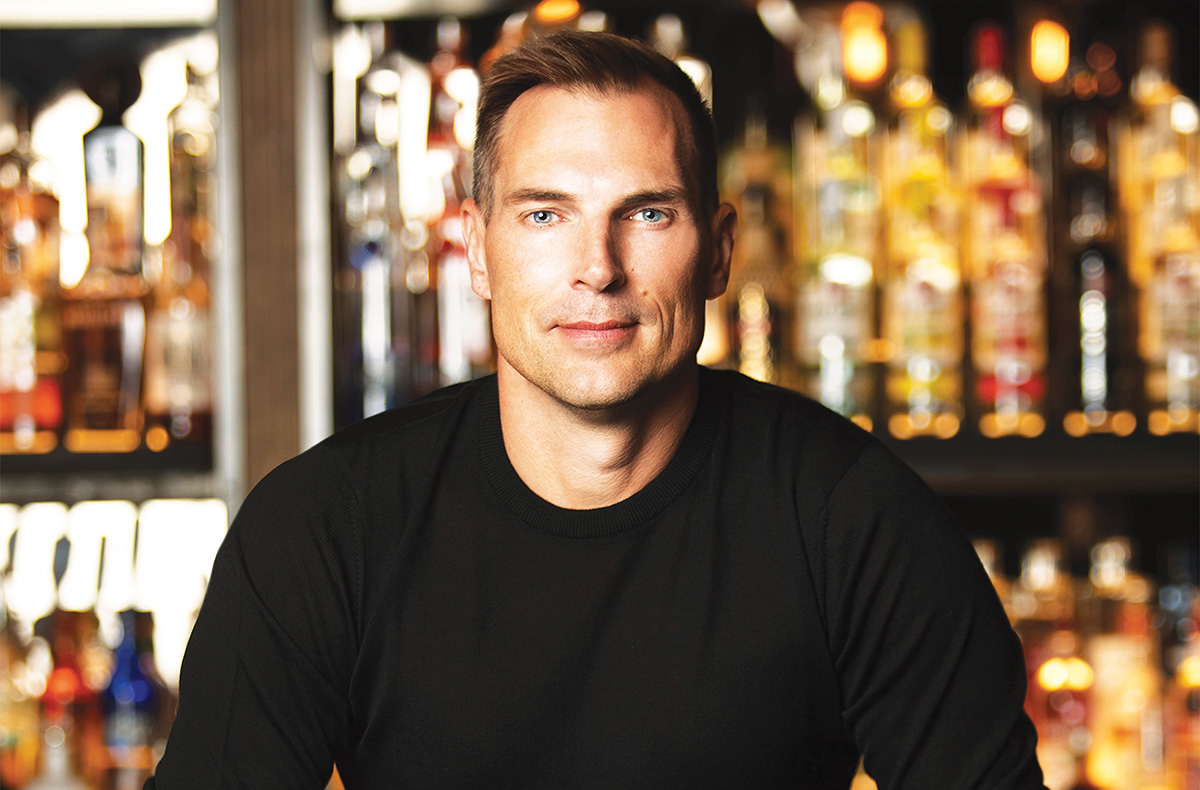
LOS ANGELES — Like the chatter about Willy Wonka and his Chocolate Factory, the West Hollywood community here started to whisper about the man who was going to be taking over the world-famous Abbey, a landmark in Los Angeles’s queer nightlife scene. Rumors were put to rest when it was announced that entrepreneur Tristan Schukraft would be taking over the legacy created by Abbey founder David Cooley. All eyes are on him.
For those of us who were there for the re-opening of The Abbey, when the torch was officially passed, all qualms about the new regime went away as it was clear the club was in good hands and that the spirit behind the Abbey would forge on. Cher, Ricky Martin, Bianca del Rio, Jean Smart, and many other celebrities rubbed shoulders with veteran patrons, and the evening was magical and a throwback to the nightclub atmosphere pre-COVID.
The much-talked-about purchase of the Abbey was just the beginning for Schukraft. It was also announced that this business impresario was set to purchase the commercial district of Fire Island, as well as projects launching in Mexico and Puerto Rico. What was he up to? Tristan sat down with the Blade to chat about it all.
“We’re at a time right now when the last generation of LGBT entrepreneurs and founders are all in their 60s and they’re retiring. And if somebody doesn’t come in and buy these places, we’re going to lose our queer spaces.”
Tristan wasn’t looking for more projects, but he recounts what happened in Puerto Rico. The Atlantic Beach Hotel was the gay destination spot and the place to party on Sundays, facing the gay beach. A new owner came in and made it a straight hotel, effectively taking away a place of fellowship and history for the queer community. Thankfully, the property is gay again, now branded as the Tryst and part of Schukraft’s portfolio with locations in Puerto Vallarta and Fire Island.
“If that happens with the Abbey and West Hollywood, it’s like Bloomingdale’s in a mall. It’s kind of like a domino effect. So that’s really what it is all about for me at this point. It has become a passion project, and I think now more than ever, it’s really important.”
Tristan is fortifying spaces for the queer community at a time when the current administration is trying to silence the LGBTQ+ community. The timing is not lost on him.
“I thought my mission was important before, and in the last couple of months, it’s become even more important. I don’t know why there’s this effort to erase us from public life, but we’ve always been here. We’re going to continue to be here, and it brings even more energy and motivation for me to make sure the spaces that I have now and even additional venues are protected going in the future.”
The gay community is not always welcoming to fresh faces and new ideas. Schukraft’s takeover of the Abbey and Fire Island has not come without criticism. Who is this man, and how dare he create a monopoly? As Schukraft knows, there will always be mean girls ready to talk. In his eyes, if someone can come in and preserve and advance spaces for the queer community, why would we oppose that?
“I think the community should be really appreciative. We, as a community, now, more than ever, should stand together in solidarity and not pick each other apart.”
As far as the Abbey is concerned, Schukraft is excited about the changes to come. Being a perfectionist, he wants everything to be aligned, clean, and streamlined. There will be changes made to the DJ and dance booth, making way for a long list of celebrity pop-ups and performances. But his promise to the community is that it will continue to be the place to be, a place for the community to come together, for at least another 33 years.
“We’re going to build on the Abbey’s rich heritage as not only a place to go at night and party but a place to go in the afternoon and have lunch. That’s what David Cooley did that no others did before, is he brought the gay bar outside, and I love that.”
Even with talk of a possible decline in West Hollywood’s nightlife, Schukraft maintains that though the industry may have its challenges, especially since COVID, the Abbey and nightlife will continue to thrive and grow.
“I’m really encouraged by all the new ownership in [nightlife] because we need another generation to continue on. I’d be more concerned if everybody was still in their sixties and not letting go.”
In his opinion, apps like Grindr have not killed nightlife.
“Sometimes you like to order out, and sometimes you like to go out, and sometimes you like to order in, right? There’s nothing that really replaces that real human interaction, and more importantly, as we know, a lot of times our family is our friends, they’re our adopted family.
Sometimes you meet them online, but you really meet them going out to bars and meeting like-minded people. At the Abbey, every now and then, there’s that person who’s kind of building up that courage to go inside and has no wingman, doesn’t have any gay friends. So it’s really important that these spaces are fun, to eat, drink, and party. But they’re really important for the next generation to find their true identity and their new family.”
There has also been criticism that West Hollywood has become elitist and not accessible to everyone in the community. Schukraft believes otherwise. West Hollywood is a varied part of queer nightlife as a whole.
“West Hollywood used to be the only gay neighborhood, and now you’ve got Silver Lake and you’ve got parts of Downtown, which is really good because L.A., is a huge place. It’s nice to have different neighborhoods, and each offers its own flavor and personality.”
Staunch in his belief in his many projects, he is not afraid to talk about hot topics in the community, especially as they pertain to the Abbey. As anyone who goes to the Abbey on a busy night can attest to, the crowd is very diverse and inclusive. Some in the community have started to complain that gay bars are no longer for the gay community, but are succumbing to our straight visitors.
Schukraft explains: “We’re a victim of our own success. I think it’s great that we don’t need to hide in the dark shadows or in a hole-in-the-wall gay bar. I’m happy about the acceptance. I started Tryst Hotels, which is the first gay hotel. We’re not hetero-friendly, we’re not gay-friendly. We’re a gay hotel and everyone is welcome. I think as long as we don’t change our behavior or the environment in general at the Abbey, and if you want to party with us, the more than merrier.”
Schukraft’s message to the community?
“These are kind of dangerous times, right? The rights that we fought for are being taken away and are being challenged. We’re trying to be erased from public life. There could be mean girls, but we, as a community, need to stick together and unite, and make sure those protections and our identity aren’t erased. And even though you’re having a drink at a gay bar, and it seems insignificant, you’re supporting gay businesses and places for the next generation.”
a&e features
Creator Max Mutchnick on inspirations for ‘Mid-Century Modern’
Real-life friendships and loss inform plot of new Hulu show
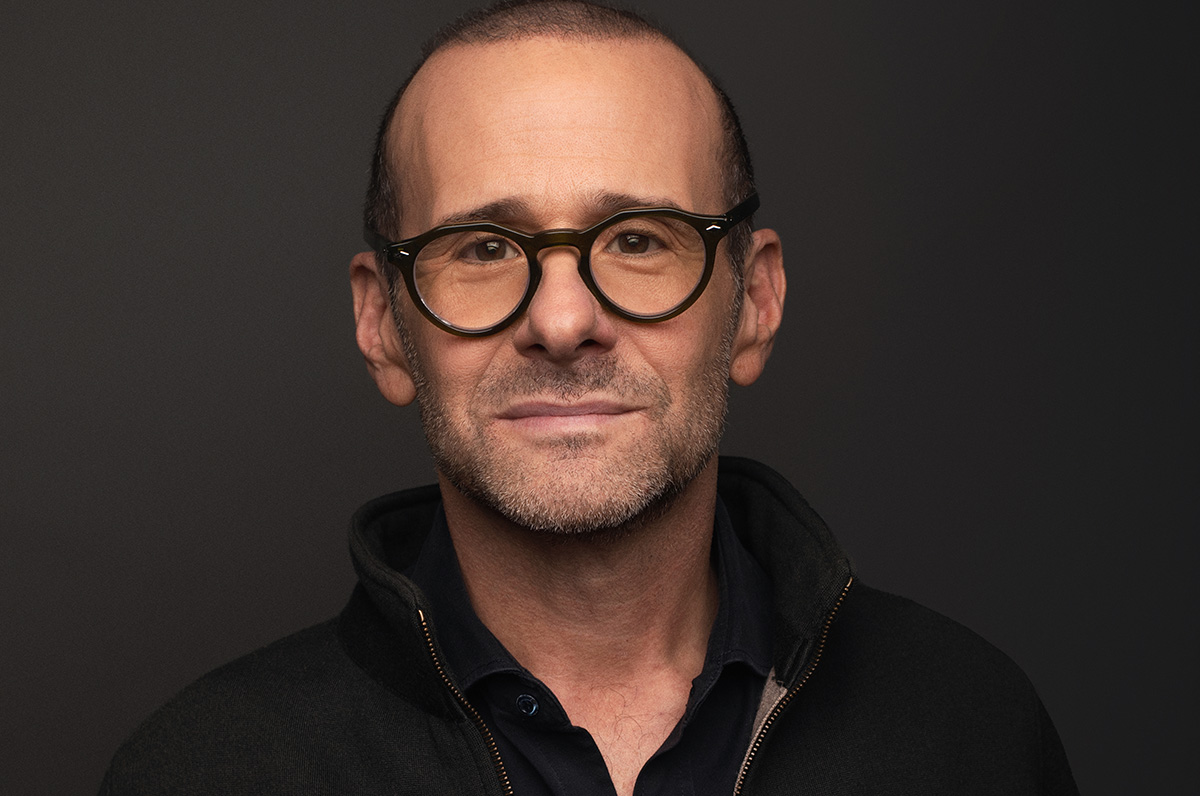
It’s been a long time – maybe 25 years when “Will & Grace” debuted – since there’s been so much excitement about a new, queer sitcom premiering. “Mid-Century Modern,” which debuted on Hulu last week, is the creation of Max Mutchnick and David Kohan, the gay men who were also behind “Will & Grace.”
Set in Palm Springs, Calif., following the death of the one of their closest friends, three gay men gather to mourn. Swept up in the emotions of the moment, Bunny (Nathan Lane) suggests that Atlanta-based flight attendant Jerry (Matt Bomer) and New York-based fashion editor Arthur (Nathan Lee Graham) move into the mid-century modern home he shares with his mother Sybil (the late Linda Lavin). Over the course of the first season’s 10 episodes, hilarity ensues. That is, except for the episode in which they address Sybil’s passing. The three male leads are all fabulous, and the ensemble cast, including Pamela Adlon as Bunny’s sister Mindy, and the stellar line-up of guest stars, such as Jesse Tyler Ferguson, Vanessa Bayer, Richard Kind, and Cheri Oteri, keep humor buzzing. Shortly before the premiere of “Mid-Century Modern,” Mutchnick made time for an interview with the Blade.
BLADE: I’d like to begin by saying it’s always a delight to speak to a fellow Emerson College alum. In ways would you say that Emerson impacted your professional and creative life?
MAX MUTCHNICK: I think Emerson was the first place that reflected back to me that my voice, my thoughts were good, and they were worth listening to. I developed a confidence at Emerson that did not exist in my body and soul. It was a collection of a lot of things that took place in Boston, but I mean we can just put it all under the Emerson umbrella.
BLADE: Before “Will & Grace,” you co-created the NBC sitcom “Boston Common,” which starred fellow Emerson alum Anthony Clark. Is it important for you to maintain those kinds of alumni relationships?
MUTCHNICK: Because Emersonians are such scrappy little monkeys and they end up being everywhere in the world, you can’t help but work with someone from Emerson at some point in your career. I’m certainly more inclined to engage with someone from Emerson once I learn that they went to my alma mater. For me, it has much more to do with history and loyalty. I don’t think of myself as one of those guys that says, “Loyalty means a lot to me. I’m someone that really leans into history.” It’s just what my life and career turned out to be. The longer I worked with people and the more often I worked with them, the safer that I felt, which means that I was more creative and that’s the name of the game. I’ve got to be as comfortable as possible so I can be as creative as possible. If that means that a person from Emerson is in the room, so be it. (Costume designer) Lori Eskowitz would be the Emerson version. And then (writer and actor) Dan Bucatinsky would be another version. When I’m around them for a long time, that’s when the best stuff comes.
BLADE: Relationships are important. On that subject, your new Hulu sitcom “Mid-Century Modern” is about the longstanding friendship among three friends, Bunny (Nathan Lane), Jerry (Matt Bomer), and Arthur (Nathan Lee Graham). Do you have a friendship like the one shared by these three men?
MUTCHNICK: I’m absolutely engaged in a real version of what we’re projecting on the show. I have that in my life. I cannot say that I’m Jerry in any way, but the one thing that we do have in common is that in my group, I’m the young one. But I think that that’s very common in these families that we create. There’s usually a young one. Our culture is built on learning from our elders. I didn’t have a father growing up, so maybe that made me that much more inclined to seek out older, wiser, funnier, meaner friends. I mean the reason why you’re looking at a mouthful of straight, white teeth is because one of those old bitches sat across from me about 25 years ago at a diner and said, “Girl, your teeth are a disaster, and you need to get that fixed immediately.” What did I know? I was just a kid from Chicago with two nickels in my pocket. But I found three nickels and I went and had new teeth put in my head. But that came from one of my dearest in the group.
BLADE: Do you think that calling “Mid-Century Modern” a gay “Golden Girls” is a fair description?
MUTCHNICK: No. I think the gay “Golden Girls” was really just used as a tool to pitch the show quickly. We have an expression in town, which is “give me the elevator pitch,” because nobody has an attention span. The fastest way you can tell someone what David (Kohan) and I wanted to write, was to say, “It’s gay Golden Girls.” When you say that to somebody, then they say, “OK, sit down now, tell me more.” We did that and then we started to dive into the show and realized pretty quickly that it’s not the gay “Golden Girls.” No disrespect to the “Golden Girls.” It’s a masterpiece.
BLADE: “Mid-Century Modern” is set in Palm Springs. I’m based in Fort Lauderdale, a few blocks south of Wilton Manors, and I was wondering if that gay enclave was ever in consideration for the setting, or was it always going to be in Palm Springs?
MUTCHNICK: You just asked a really incredible question! Because, during COVID, Matt Bomer and I used to walk, because we live close by. We had a little walking group of a few gay gentlemen. On one of those walks, Matt proposed a comedy set in Wilton Manors. He said it would be great to title the show “Wilton Manors.” I will tell you that in the building blocks of what got us to “Mid-Century Modern,” Wilton Manors, and that suggestion from Matt Bomer on our COVID walks, was part of it.
BLADE: Is Sybil, played by the late Linda Lavin, modeled after a mother you know?
MUTCHNICK: Rhea Kohan (mother of David and Jenji). When we met with Linda for the first time over Zoom, when she was abroad, David and I explained to her that this was all based on Rhea Kohan. In fact, some of the lines that she (Sybil) speaks in the pilot are the words that Jenji Kohan spoke about her mother in her eulogy at the funeral because it really summed up what the character was all about. Yes, it’s very much based on someone.
BLADE: The Donny Osmond jokes in the second episode of “Mid-Century Modern” reminded me of the Barry Manilow “fanilows” on “Will & Grace.” Do you know if Donny is aware that he’s featured in the show?
MUTCHNICK: I don’t. To tell you the truth, the “fanilow” episode was written when I was not on the show. I was on a forced hiatus, thanks to Jeff Zucker. That was a show that I was not part of. We don’t really work that way. The Donny Osmond thing came more from Matt’s character being a Mormon, and also one of the writers. It’s very important to mention that the writing room at “Mid-Century Modern,” is (made up of) wonderful and diverse and colorful incredible humans – one of them is an old, white, Irish guy named Don Roos who’s brilliant…
BLADE: …he’s Dan Bucatinsky’s husband.
MUTCHNICK: Right! Dan is also part of the writing room. But I believe it was Don who had a thing for Donny, and that’s where it comes from. I don’t know if Donny has any awareness. The only thing I care about when we turn in an episode like that is I just want to hear from legal that we’re approved.
BLADE: “Mid-Century Modern” also includes opportunities for the singers in the cast. Linda Lavin sang the Jerome Kern/Ira Gershwin tune “Long Ago (And Far Away)” and Nathan Lane and the guys sang “He Had It Coming” from “Chicago.” Was it important to give them the chance to exercise those muscles?
MUTCHNICK: I don’t think it was. I think it really is just the managers’ choice. David Kohan and I like that kind of stuff, so we write that kind of stuff. But by no means was there an edict to write that. We know what our cast is capable of, and we will absolutely exploit that if we’re lucky enough to have a second season. I have a funky relationship with the song “Long Ago (And Far Away).” It doesn’t float my boat, but everybody else loved it. We run a meritocracy, and the best idea will out. That’s how that song ended up being in the show. I far prefer the recording of Linda singing “I’ll Be Seeing You” over her montage in episode eight, “Here’s To You, Mrs. Schneiderman.” We were just lucky that Linda had recorded that. That recording was something that she had done and sent to somebody during COVID because she was held up in her apartment. That’s what motivated her to make that video and send it. That’s how we were able to use that audio.
BLADE: Being on a streaming service like Hulu allows for characters to say things they might not get away with on network TV, including a foreskin joke, as well as Sybil’s propensity for cursing.
MUTCHNICK: And the third line in the show is about him looking like a “reluctant bottom.” I don’t think that’s something you’re going to see on ABC anytime soon. David and I liked the opportunity to open up the language of this show because it might possibly open the door to bringing people…I’m going to mix metaphors…into the tent that have never been there before. A generation that writes off a sitcom because that language and that type of comedy isn’t the way that they sound. One of the gifts of doing this show on Hulu is that we get to write dialogue that sounds a little bit more like you and I sound. As always, we don’t want to do anything just to do it.
BLADE: It didn’t feel that way.
MUTCHNICK: It’s there when it’s right. [Laughs] I want to have a shirt made with Linda’s line, as her mother always used to say, “Time is a cunt.”
BLADE: “Mid-Century Modern” also utilizes a lot of Jewish humor. How important is it for you to include that at this time when there is a measurable rise in anti-Semitism?
MUTCHNICK: I think it’s important, but I don’t think it’s the reason why we did it. We tried very hard to not write from a place of teaching or preaching. We really are just writing about the stuff that makes us laugh. One of the things that makes something better and something that you can invest in is if it’s more specific. We’re creating a character whose name is Bunny Schneiderman and his mother’s name is Sybil and they made their money in a family-run business, it gets Jewy, and we’re not going to shy away from it. But we’re definitely not going to address what’s going on in the world. That doesn’t mean I don’t find it very upsetting, but I’m writing always from the point of view of entertaining the largest number of people that I can every week.
BLADE: “Mid-Century Modern” has a fantastic roster of guest stars including Jesse Tyler Ferguson, Vanessa Bayer, Billie Lourd, Cheri Oteri, Richard Kind, Rhea Perlman, and Judd Hirsch. Are there plans to continue that in future seasons?
MUTCHNICK: Yes. As I keep saying, if we’re so lucky that we get to continue, I don’t want to do “The Love Boat.” Those are fine comic actors, so I don’t think it feels like that. But if we get to keep going, what I want to do is broaden the world because that gives us more to write about. I want to start to introduce characters that are auxiliary to the individuals. I want to start to meet Arthur’s family, so we can return to people. I want to introduce other neighbors, and different types of gay men because we come in so many different flavors. I think that we should do that only because I’m sure it’s what your life is and it’s what my life is. I’ve got a lot of different types. So, yes, we will be doing more.
BLADE: Finally, Linda Lavin passed away in December 2024, and in a later episode, the subject of her character Sybil’s passing is handled sensitively, including the humorous parts.
MUTCHNICK: We knew we had a tall order. We suffered an incredible loss in the middle of making this comedy. One of the reasons why I think this show works is because we are surrounded by a lot of really talented people. Jim Burrows and Ryan Murphy, to name two. Ryan played a very big role in telling us that it was important that we address this, that we address it immediately. That we show the world and the show goes on. That wasn’t my instinct because I was so inside the grief of losing a friend, because she really was. It wasn’t like one of those showbizzy-type relationships. And this is who she was, by the way, to everybody at the show. It was the way that we decided to go. Let’s write this now. Let’s not put this at the end of the season. Let’s not satellite her in. Let’s not “Darren Stevens” the character, which is something we would never do. The other thing that Jim Burrows made very clear to us was the import of the comedy. You have to write something that starts exactly in the place that these shows start. A set comedy piece that takes place in the kitchen. Because for David and me, as writers, we said we just want to tell the truth. That’s what we want to do with this episode and that’s the way that this will probably go best for us. The way that we’ve dealt with grief in our lives is with humor. That is the way that we framed writing this episode. We wanted it to be a chapter from our lives, and how we experience this loss and how we recover and move on.
a&e features
Margaret Cho returns to music with ‘Lucky Gift’
Collection of pop tunes includes tribute to non-binary people
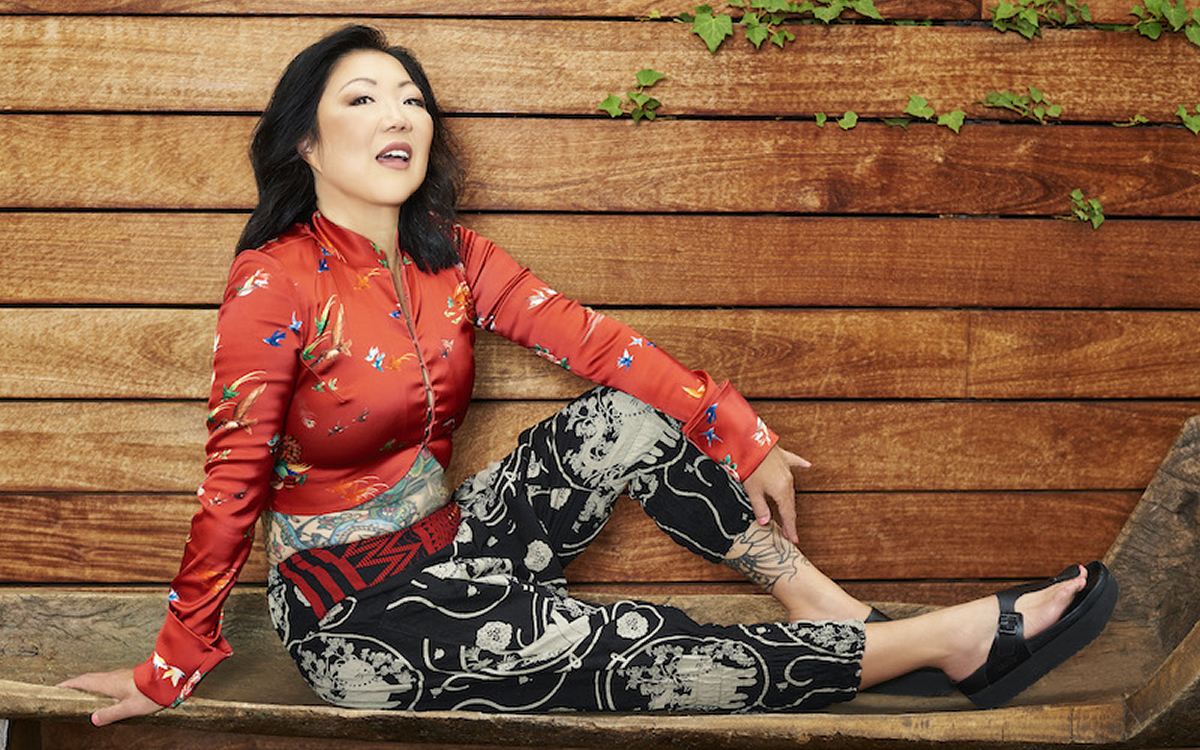
LOS ANGELES — It has been eight years since Margaret Cho released her Grammy-nominated “American Myth” album. She’s back to the music scene with her new album, “Lucky Gift,” an 11-track collection of anthems and pop tunes, a tribute to Robin Williams, and a shout-out to non-binary and gender non-conforming people.
The album captures the whirlwind that is Margaret and all of the different facets of her talents that have made her a powerhouse in entertainment and a leader in activism. In “Lucky Gift,” she’s getting her point across while having fun and getting glam.
We caught up with the activist and artist to chat about her music, our political climate, and the power of pop divas.
Known for her comedy, acting, and activism, she felt it was long overdue to get her music back out there too.
“I make music often. It’s a part of my daily life, it’s a big part of my social life, and it’s just something that I just love to do for my own relaxation and fun. I had enough for an album and I wanted to finally put them out. I was just really proud of how it all sounded together,” shares Cho.
“It’s a power pop record. For me, the songs are really meaningful. They’re all in their own way love songs. I’m a big fan of my own music (laughs), I really like the way that I sound and it’s really special to do. People know me as a comedian, and I have also made music for a long time, but it’s sort of a side project, and so it was time to put more out again.”
Her album also includes a touching tribute to Robin Williams. The entertainment community is finally more comfortable talking about mental health more openly. When relating mental health to her own life, Margaret, in true Margaret form, quickly turned the conversation to reflect today’s political climate.
“I have to maintain a level of peace and quiet and sometimes maybe get away from the news, although that’s tough because I am obsessed. I want to know what is happening. I’m really worried for our community, especially the trans community. I’m worried that this administration is trying to separate T and the Q from the LGBTQIA, and it’s really frightening.”
As an elder, Cho says she has to also remember that we’ve been through this before and it’s actually been much worse. As a community, we’ve been through a similar situation, and we were facing down a pandemic, which was killing us by the millions. So at least now we don’t have to fight AIDS as well as this onslaught of homophobia.
“We have fought for our rights, and we still have them, but we may not have them for long. So our mental health is very important to preserve now because we have to fight. The one thing to remember is they can’t do everything at once. They can’t take away trans rights, queer rights, gay rights, gay marriage, anti-depressants —ha — at the same time. So what we can do is just try to remain as calm as possible and fight as strongly as we can. But yeah, mental health is really vitally important right now.”
Margaret’s long history of queer activism stands for itself. She does not shy away from current issues, she uses her platforms to incite, educate, and question. For Margaret, there is no time off from being an activist. She was born into it, so to speak, being raised in San Francisco in the 1970s, her parents — the owners of a gay bookstore — and their employees followers of Harvey Milk.
“My activism is that I don’t have a choice. I’m going to be an activist no matter what. We’re doing this together, we’re going through this together. I will always be political. It’s just disheartening to see the ignorance of people and the lies that are being told that are believed.”
Margaret’s “Lucky Gift” comes at a perfect time when the queer community can come together over music. Cho looks at her album as a tool to empower an underdog community through the power of music.
“It’s the triumph of pop above all. We need to look to our pop divas above all. So now I’m more than ever, leaning on Madonna. [Thank God for Lady Gaga’s] “Abracadabra” because I think that things like that boost our community so much. When you can just get together and have a “brat summer,” that boosts our community so much in this togetherness, this explosion of excitement. I think Chappell Roan really ignited the pop capacity for healing. I love ‘Lucky Gift’ because it is my stepping into a pop diva moment. Pop divas should not be discounted for how important they are to our society and how much they lift us up.”
In addition to releasing her new album, Cho will continue to hit the road this year with her “Live and LIVID! Tour,” celebrating more than four decades of live stand-up shows. On this tour, she promises to rage about homophobia, sexism, racism, and the fight to stay alive. The five-time Grammy and Emmy-nominated performer is not holding back. According to her, the nation is not divided, just a little lost.
“We’re not divided. Everybody hates this. We all hate this. The fact is, the majority of the country does not want this. Unfortunately, a lot of people just didn’t vote because they just didn’t want to participate. That’s why we’re in the situation that we’re in. So to be on the road is a pleasure. And I rarely come against opposition. Every once in a while there’s something, but it’s something that we all handle. I think we all need a voice, a strong voice of reason to combat all of the hysteria.”
And her message to her fans?
“We’ll get through this. We’ll get through this with pop divas. ‘Abracadabra,’ learn the choreography, you do it sitting down. At least we have pop music, I have my hat in the ring here. But at least we have each other and we’re going to be OK. It’s going to be a ride, it’s going to be intense, but we can do this. We’ve been through this before and we are going to be fine.”
“Lucky Gift”is now available on all major streaming platforms.
-

 District of Columbia4 days ago
District of Columbia4 days agoWorldPride organizers may warn trans people from abroad not to attend event
-

 Opinions3 days ago
Opinions3 days agoIt’s time for new leadership on the Maryland LGBTQIA+ Commission
-

 The White House3 days ago
The White House3 days agoWhite House does not ‘respond’ to reporters’ requests with pronouns included
-

 Noticias en Español4 days ago
Noticias en Español4 days agoINDIGNACIÓN: ¡El transfeminicidio de Sara Millerey en Colombia nos cuestiona como sociedad!

